Vegetable tannins - lessons of a phytochemical lifetime
【中英双语】健康饮食小指南

【中英双语】健康饮食小指南The fibre contained in leafy green vegetables acts like a scrubbing brush in the gut, helping to reduce the absorption of microbial toxins into the body.绿叶蔬菜中所含的纤维素就像人体肠内的刷子一样,它有助于减少人体对微生物毒素的吸收。
Eating more fruit and vegetables satisfies your hunger and means you'll be less likely to reach for high-fat, high-sugar and low-fibre foods.多吃水果和蔬菜能充饥,这样你就不会太想吃脂肪和糖含量高,而纤维素含量低的食物。
Eating a diet high in unprocessed and natural foods is one of the best things you can do for your health, along with taking enough exercise and getting sufficient rest.多吃未经加工的,天然的食物,并做足够的锻炼,保证一定的休息时间,对你的健康有好处。
Green leafy vegetables are high in folate and iron and assist in healthy cell development.绿叶蔬菜富含大量叶酸和铁元素,有助于细胞的健康生长。
The phyto-chemicals in vegetables and other plant foods may help to ward off the toxic effects of ozone, the main component of smog, smoke and environmental pollution.蔬菜和其他植物性食物中所含的植物化学成分有望防止臭氧对人体造成伤害,臭氧是烟雾的主要成分,而烟雾是由煤烟和环境污染物构成的。
蔬菜栽培传统工艺英语作文
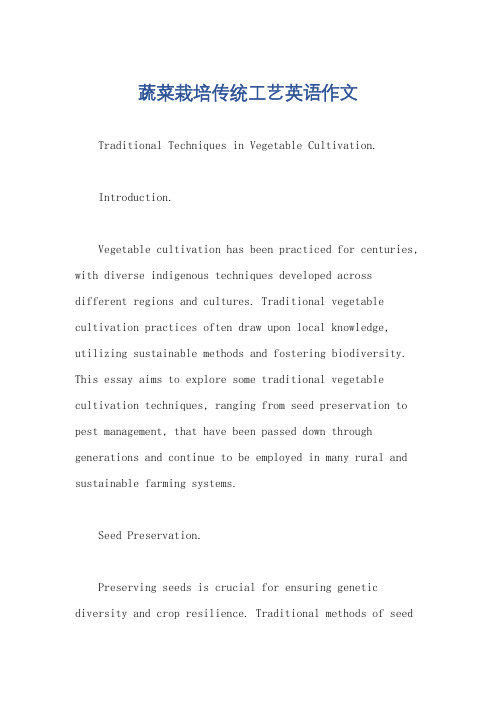
蔬菜栽培传统工艺英语作文Traditional Techniques in Vegetable Cultivation.Introduction.Vegetable cultivation has been practiced for centuries, with diverse indigenous techniques developed across different regions and cultures. Traditional vegetable cultivation practices often draw upon local knowledge, utilizing sustainable methods and fostering biodiversity. This essay aims to explore some traditional vegetable cultivation techniques, ranging from seed preservation to pest management, that have been passed down through generations and continue to be employed in many rural and sustainable farming systems.Seed Preservation.Preserving seeds is crucial for ensuring genetic diversity and crop resilience. Traditional methods of seedpreservation include:Dry Storage: Seeds are dried to reduce moisture content and stored in cool, dry places. This method is suitable for many vegetables, such as beans, peas, and tomatoes.Vernalization: Seeds are exposed to cold temperatures to stimulate germination. This is particularly importantfor vegetables that require a period of cold treatment to break dormancy, such as carrots and spinach.Grafting: A technique where two different plant species are joined together, with the rootstock providing support and the scion (the desired vegetable) providing the edible parts. Grafting can improve plant vigor, disease resistance, and yield.Soil Management.Healthy soil is the foundation of productive vegetable gardens. Traditional soil management techniques include:Composting: Creating organic matter-rich compost by decomposing plant and animal materials. Compost improves soil structure, fertility, and water retention.Mulching: Covering the soil with a layer of organic material, such as straw, wood chips, or leaves. Mulching suppresses weeds, conserves moisture, and protects the soil from erosion.Crop Rotation: Planting different types of vegetables in sequence in the same area over time. Crop rotation helps maintain soil health, break pest and disease cycles, and increase nutrient availability.Water Management.Efficient water management is crucial in vegetable cultivation. Traditional techniques include:Rainwater Harvesting: Collecting and storing rainwater for irrigation purposes. This can be achieved through watercatchment systems such as rain barrels or cisterns.Drip Irrigation: A method of delivering water directly to the roots of plants, minimizing evaporation and water loss. Drip irrigation conserves water and reduces disease incidence.Mulching: As mentioned earlier, mulching helps retain soil moisture and reduces the frequency of watering.Pest and Disease Management.Natural pest and disease management techniques have been used for centuries to protect vegetable crops. These include:Companion Planting: Planting specific species of plants together to repel pests or attract beneficial insects. For example, planting marigolds near tomatoes helps repel nematodes.Crop Rotation: Crop rotation, as discussed above, canhelp disrupt pest and disease life cycles and prevent buildup in the soil.Beneficial Insects: Encouraging beneficial insects, such as ladybugs and lacewings, to control pests. These insects can prey on or parasitize harmful insects, reducing their populations.Organic Insecticides and Fungicides: Using natural substances, such as neem oil or garlic spray, to combat pests and diseases. These alternatives minimize the use of synthetic chemicals and protect beneficial organisms.Conclusion.Traditional vegetable cultivation techniques embody the wisdom and experience accumulated over generations. These methods promote sustainable farming practices, preserve crop diversity, and foster a deep connection between humans and the land. By integrating these traditional techniques into modern agriculture, we can enhance food security,protect the environment, and preserve the rich tapestry of cultural practices associated with vegetable cultivation.。
英语单词蔬菜水果汇
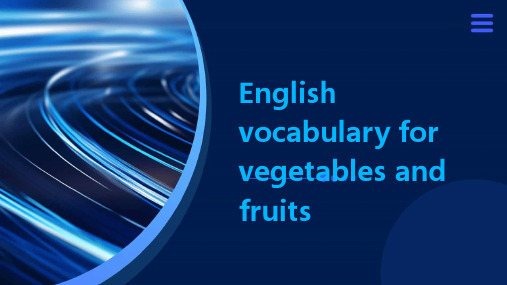
CATALOGUE
05
By combining vegetable words, improve vocabulary memory and language organization skills.
Summary
Players need to combine randomly selected vegetable words into meaningful phrases or sentences within a specified time, such as "carry and tomato soup", "peas and beans salad", to enhance their memory and understanding of vegetable words.
Mix the English names of some fruits on a piece of paper, and then have students spell and pronounce the English names of these fruits together. The student who completes the puzzle first is the winner.
contents
目录
Fruits
CATALOGUE
01
Summary: Apples are a common fruit with a crispy and sweet taste, and are rich in nutrients.
Summary: Banana is a tropical fruit with a soft and sticky taste and a sweet taste.
植物专家的英语
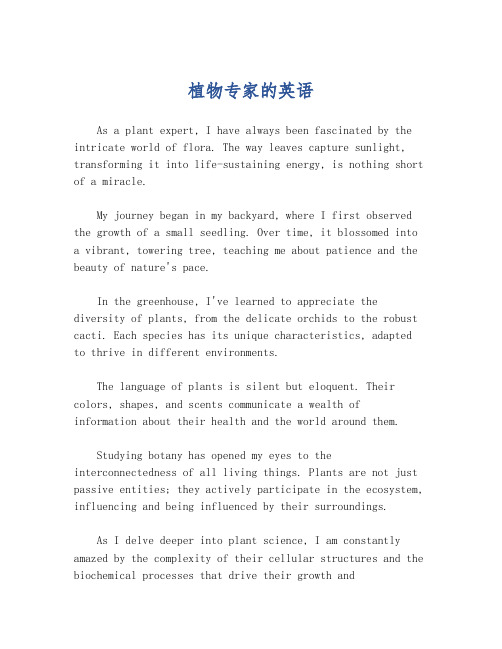
植物专家的英语As a plant expert, I have always been fascinated by the intricate world of flora. The way leaves capture sunlight, transforming it into life-sustaining energy, is nothing short of a miracle.My journey began in my backyard, where I first observed the growth of a small seedling. Over time, it blossomed into a vibrant, towering tree, teaching me about patience and the beauty of nature's pace.In the greenhouse, I've learned to appreciate the diversity of plants, from the delicate orchids to the robust cacti. Each species has its unique characteristics, adapted to thrive in different environments.The language of plants is silent but eloquent. Their colors, shapes, and scents communicate a wealth of information about their health and the world around them.Studying botany has opened my eyes to the interconnectedness of all living things. Plants are not just passive entities; they actively participate in the ecosystem, influencing and being influenced by their surroundings.As I delve deeper into plant science, I am constantly amazed by the complexity of their cellular structures and the biochemical processes that drive their growth andreproduction.Sharing my knowledge with others is a joy. Whether it's through workshops, lectures, or casual conversations, I find great satisfaction in helping people appreciate the marvels of the plant kingdom.In my quest to become a better plant expert, I continue to learn new techniques and theories. The field of botany is ever-evolving, and I am excited to see where it will take us next.。
关于掐菜苔的400字英语作文
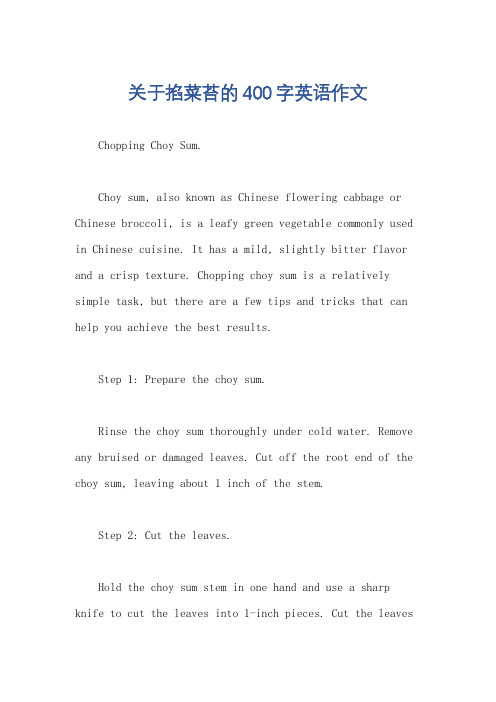
关于掐菜苔的400字英语作文Chopping Choy Sum.Choy sum, also known as Chinese flowering cabbage or Chinese broccoli, is a leafy green vegetable commonly used in Chinese cuisine. It has a mild, slightly bitter flavor and a crisp texture. Chopping choy sum is a relatively simple task, but there are a few tips and tricks that can help you achieve the best results.Step 1: Prepare the choy sum.Rinse the choy sum thoroughly under cold water. Remove any bruised or damaged leaves. Cut off the root end of the choy sum, leaving about 1 inch of the stem.Step 2: Cut the leaves.Hold the choy sum stem in one hand and use a sharp knife to cut the leaves into 1-inch pieces. Cut the leavesacross the grain, which will help to prevent them from becoming tough.Step 3: Cut the stems.Cut the choy sum stems into 1-inch pieces. You can cut the stems on a diagonal to increase the surface area and allow them to cook more evenly.Step 4: Wash the choy sum.Rinse the chopped choy sum thoroughly under cold water. This will remove any dirt or debris.Step 5: Drain the choy sum.Drain the choy sum in a colander or salad spinner. You can also pat it dry with a paper towel.Tips for chopping choy sum.Use a sharp knife to cut the choy sum. A dull knifewill crush the leaves and stems, making them tough.Cut the choy sum across the grain to prevent it from becoming tough.Chop the choy sum into uniform pieces so that it cooks evenly.Rinse the choy sum thoroughly after chopping to remove any dirt or debris.How to use chopped choy sum.Chopped choy sum can be used in a variety of dishes, including stir-fries, soups, and salads. It is a good source of vitamins and minerals, including vitamin C, vitamin A, and calcium.Here are some recipes that use chopped choy sum:Stir-fried choy sum with garlic.Choy sum soup.Choy sum salad with sesame dressing.Chopping choy sum is a simple task that can be completed in a few minutes. By following the tips and tricks above, you can achieve the best results and enjoy the delicious flavor of this versatile vegetable.。
植物的作文黄瓜
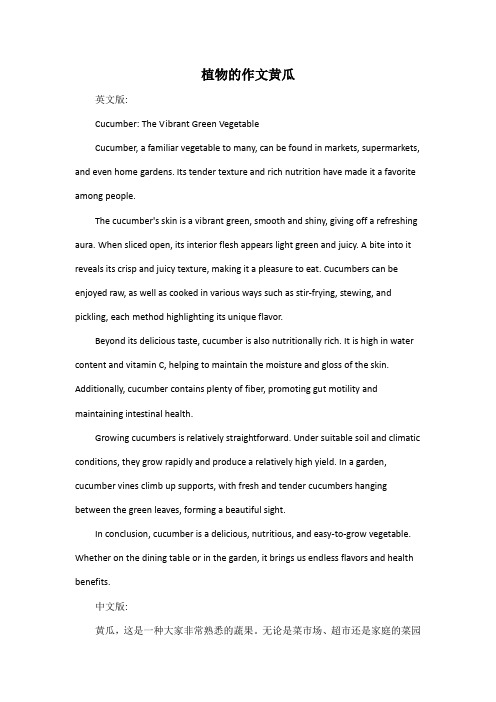
植物的作文黄瓜英文版:Cucumber: The Vibrant Green VegetableCucumber, a familiar vegetable to many, can be found in markets, supermarkets, and even home gardens. Its tender texture and rich nutrition have made it a favorite among people.The cucumber's skin is a vibrant green, smooth and shiny, giving off a refreshing aura. When sliced open, its interior flesh appears light green and juicy. A bite into it reveals its crisp and juicy texture, making it a pleasure to eat. Cucumbers can be enjoyed raw, as well as cooked in various ways such as stir-frying, stewing, and pickling, each method highlighting its unique flavor.Beyond its delicious taste, cucumber is also nutritionally rich. It is high in water content and vitamin C, helping to maintain the moisture and gloss of the skin. Additionally, cucumber contains plenty of fiber, promoting gut motility and maintaining intestinal health.Growing cucumbers is relatively straightforward. Under suitable soil and climatic conditions, they grow rapidly and produce a relatively high yield. In a garden, cucumber vines climb up supports, with fresh and tender cucumbers hanging between the green leaves, forming a beautiful sight.In conclusion, cucumber is a delicious, nutritious, and easy-to-grow vegetable. Whether on the dining table or in the garden, it brings us endless flavors and health benefits.中文版:黄瓜,这是一种大家非常熟悉的蔬果。
外国蔬菜专家介绍英文作文
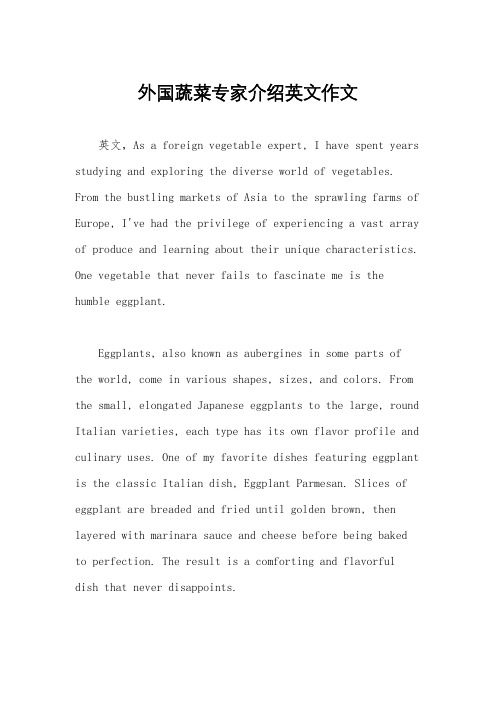
外国蔬菜专家介绍英文作文英文,As a foreign vegetable expert, I have spent years studying and exploring the diverse world of vegetables. From the bustling markets of Asia to the sprawling farms of Europe, I've had the privilege of experiencing a vast array of produce and learning about their unique characteristics. One vegetable that never fails to fascinate me is the humble eggplant.Eggplants, also known as aubergines in some parts of the world, come in various shapes, sizes, and colors. From the small, elongated Japanese eggplants to the large, round Italian varieties, each type has its own flavor profile and culinary uses. One of my favorite dishes featuring eggplant is the classic Italian dish, Eggplant Parmesan. Slices of eggplant are breaded and fried until golden brown, then layered with marinara sauce and cheese before being baked to perfection. The result is a comforting and flavorful dish that never disappoints.中文,作为一名外国蔬菜专家,我已经花了多年的时间研究和探索多样化的蔬菜世界。
关于蔬菜研究的作文英语
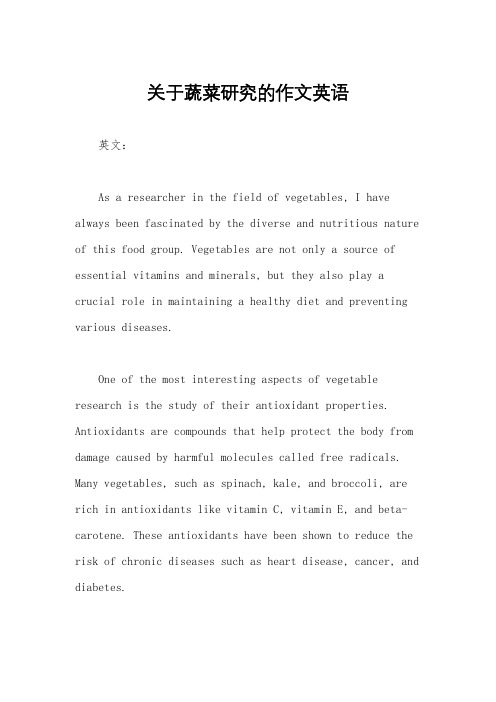
关于蔬菜研究的作文英语英文:As a researcher in the field of vegetables, I have always been fascinated by the diverse and nutritious nature of this food group. Vegetables are not only a source of essential vitamins and minerals, but they also play a crucial role in maintaining a healthy diet and preventing various diseases.One of the most interesting aspects of vegetable research is the study of their antioxidant properties. Antioxidants are compounds that help protect the body from damage caused by harmful molecules called free radicals. Many vegetables, such as spinach, kale, and broccoli, are rich in antioxidants like vitamin C, vitamin E, and beta-carotene. These antioxidants have been shown to reduce the risk of chronic diseases such as heart disease, cancer, and diabetes.In addition to their health benefits, vegetables also offer a wide range of flavors and textures that can enhance the overall dining experience. For example, I have conducted research on different varieties of tomatoes and found that their taste and aroma can vary significantly based on factors such as soil quality, climate, and cultivation methods. This has led to the development of new and improved tomato varieties that are not only more flavorful but also more resistant to pests and diseases.Furthermore, my research has also focused on the environmental impact of vegetable production. I have studied sustainable farming practices that minimize the use of pesticides and fertilizers, reduce water consumption, and promote soil health. By implementing these practices, farmers can not only protect the environment but also produce healthier and more nutritious vegetables.Overall, my work in vegetable research has allowed me to gain a deeper understanding of the importance of incorporating a variety of vegetables into our diet. Whether it's the vibrant colors of bell peppers, thecrispness of lettuce, or the earthy sweetness of carrots, each vegetable brings its own unique qualities to the table.中文:作为蔬菜领域的研究者,我一直对这种多样化和营养丰富的食物群感到着迷。
蔬菜英语启蒙教育
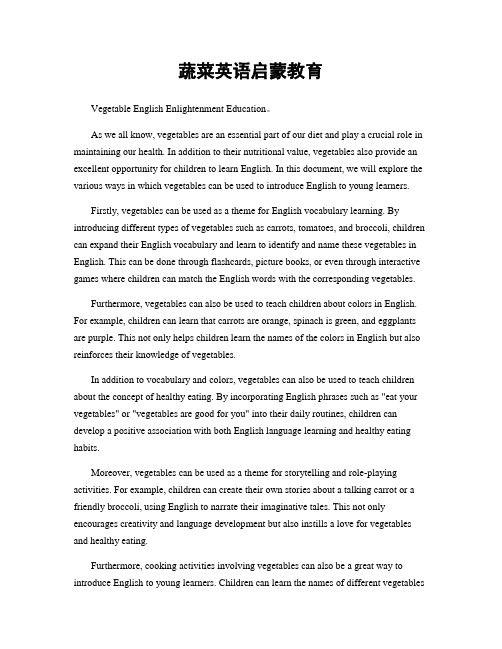
蔬菜英语启蒙教育Vegetable English Enlightenment Education。
As we all know, vegetables are an essential part of our diet and play a crucial role in maintaining our health. In addition to their nutritional value, vegetables also provide an excellent opportunity for children to learn English. In this document, we will explore the various ways in which vegetables can be used to introduce English to young learners.Firstly, vegetables can be used as a theme for English vocabulary learning. By introducing different types of vegetables such as carrots, tomatoes, and broccoli, children can expand their English vocabulary and learn to identify and name these vegetables in English. This can be done through flashcards, picture books, or even through interactive games where children can match the English words with the corresponding vegetables.Furthermore, vegetables can also be used to teach children about colors in English. For example, children can learn that carrots are orange, spinach is green, and eggplants are purple. This not only helps children learn the names of the colors in English but also reinforces their knowledge of vegetables.In addition to vocabulary and colors, vegetables can also be used to teach children about the concept of healthy eating. By incorporating English phrases such as "eat your vegetables" or "vegetables are good for you" into their daily routines, children can develop a positive association with both English language learning and healthy eating habits.Moreover, vegetables can be used as a theme for storytelling and role-playing activities. For example, children can create their own stories about a talking carrot or a friendly broccoli, using English to narrate their imaginative tales. This not only encourages creativity and language development but also instills a love for vegetables and healthy eating.Furthermore, cooking activities involving vegetables can also be a great way to introduce English to young learners. Children can learn the names of different vegetablesas they help prepare simple dishes such as salads or stir-fries. This hands-on approach not only reinforces their English vocabulary but also teaches them valuable life skills in the kitchen.In conclusion, vegetables provide a wealth of opportunities for children to learn English in a fun and engaging way. By incorporating vegetables into English language learning, children can develop a strong foundation in both language and healthy eating habits. So let's embrace the power of vegetables and use them to enlighten and educate our young learners in English!。
介绍番茄根茎种子花朵叶子的英语作文
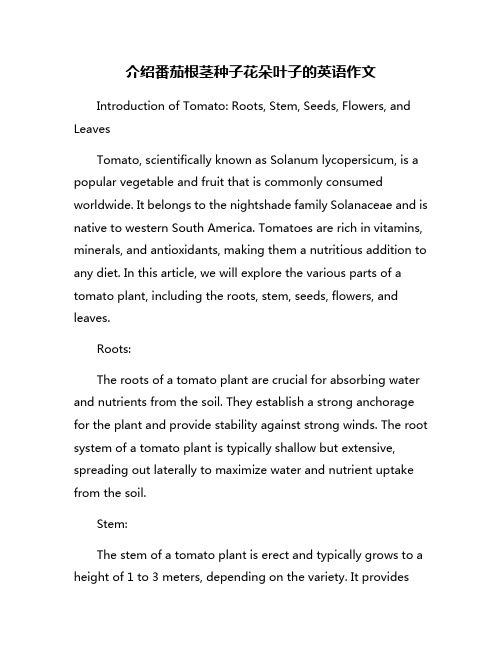
介绍番茄根茎种子花朵叶子的英语作文Introduction of Tomato: Roots, Stem, Seeds, Flowers, and LeavesTomato, scientifically known as Solanum lycopersicum, is a popular vegetable and fruit that is commonly consumed worldwide. It belongs to the nightshade family Solanaceae and is native to western South America. Tomatoes are rich in vitamins, minerals, and antioxidants, making them a nutritious addition to any diet. In this article, we will explore the various parts of a tomato plant, including the roots, stem, seeds, flowers, and leaves.Roots:The roots of a tomato plant are crucial for absorbing water and nutrients from the soil. They establish a strong anchorage for the plant and provide stability against strong winds. The root system of a tomato plant is typically shallow but extensive, spreading out laterally to maximize water and nutrient uptake from the soil.Stem:The stem of a tomato plant is erect and typically grows to a height of 1 to 3 meters, depending on the variety. It providessupport for the plant and transports water and nutrients from the roots to the leaves and flowers. The stem also houses the vascular system, which includes xylem and phloem tissues responsible for the transportation of water and food throughout the plant.Seeds:Tomato seeds are contained within the fruit, which is botanically classified as a berry. Each tomato fruit can contain dozens to hundreds of seeds, which are surrounded by a gel-like substance known as the tomato placenta. Tomato seeds are typically small, flat, and yellowish in color, with a hard outer coating that protects the embryo inside.Flowers:Tomato plants produce small yellow flowers that areself-pollinating, meaning they can pollinate themselves without the need for external pollinators. The flowers consist of both male and female reproductive organs, with the male stamens producing pollen and the female pistil containing the ovary. Once pollinated, the ovary develops into a fruit that houses the tomato seeds.Leaves:The leaves of a tomato plant are green, oblong, and serrated, with a distinct pinnate venation pattern. They play a crucial role in photosynthesis, the process by which plants convert sunlight into energy to fuel their growth and development. Tomato leaves also help regulate water loss through transpiration and provide protection against pests and diseases.In conclusion, the tomato plant is a versatile and nutritious crop that offers a wide range of health benefits. By understanding the various parts of a tomato plant, including the roots, stem, seeds, flowers, and leaves, we can appreciate the complexity and beauty of this remarkable vegetable. Whether eaten raw in salads, cooked into sauces, or juiced for beverages, tomatoes are a delicious and versatile ingredient that can be enjoyed in a variety of culinary applications.。
秋葵做英语作文
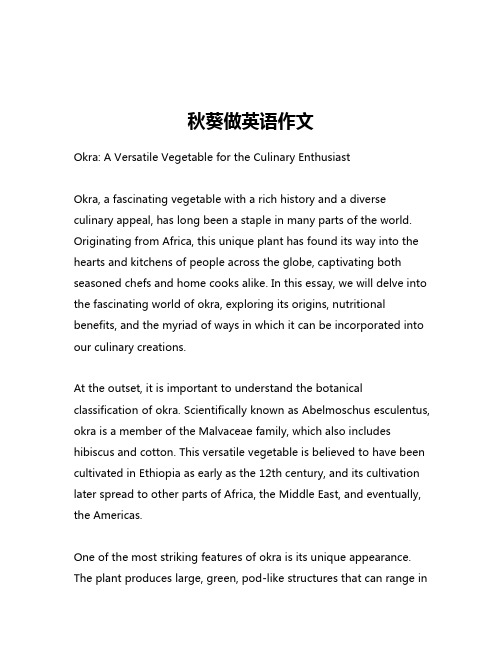
秋葵做英语作文Okra: A Versatile Vegetable for the Culinary EnthusiastOkra, a fascinating vegetable with a rich history and a diverse culinary appeal, has long been a staple in many parts of the world. Originating from Africa, this unique plant has found its way into the hearts and kitchens of people across the globe, captivating both seasoned chefs and home cooks alike. In this essay, we will delve into the fascinating world of okra, exploring its origins, nutritional benefits, and the myriad of ways in which it can be incorporated into our culinary creations.At the outset, it is important to understand the botanical classification of okra. Scientifically known as Abelmoschus esculentus, okra is a member of the Malvaceae family, which also includes hibiscus and cotton. This versatile vegetable is believed to have been cultivated in Ethiopia as early as the 12th century, and its cultivation later spread to other parts of Africa, the Middle East, and eventually, the Americas.One of the most striking features of okra is its unique appearance. The plant produces large, green, pod-like structures that can range insize from a few inches to over a foot in length. These pods are covered in a fuzzy, ridged exterior, which can sometimes be mistaken for a protective mechanism. However, this texture is an integral part of the vegetable's charm, adding a distinct visual appeal to any dish.In terms of its nutritional profile, okra is a powerhouse of essential vitamins and minerals. It is an excellent source of vitamin C, which plays a crucial role in immune system function and skin health. Additionally, okra is rich in folate, a B-vitamin that is particularly important during pregnancy. Furthermore, this vegetable boasts a significant amount of dietary fiber, which can aid in digestive health and promote a feeling of fullness.One of the most captivating aspects of okra is its versatility in the kitchen. This vegetable can be prepared in a myriad of ways, each highlighting its unique texture and flavor profile. In many parts of the world, okra is a staple ingredient in stews, curries, and soups, where its slightly mucilaginous texture helps to thicken and enrich the dish.In the Southern United States, okra is often fried, creating a crispy, golden-brown exterior that contrasts beautifully with the tender interior. This method of preparation has become a beloved classic, with many home cooks and restaurants offering their own unique takes on fried okra.Beyond its savory applications, okra can also be enjoyed in more unexpected ways. In some cultures, the young, tender pods are pickled, creating a tangy and crunchy condiment that can be served alongside a variety of dishes. In India, okra is often stir-fried with spices and onions, resulting in a flavorful and aromatic side dish.One of the most intriguing aspects of okra is its ability to adapt to different culinary traditions and flavor profiles. In West African cuisine, okra is a key ingredient in the iconic dish known as Jollof rice, where it contributes both texture and depth of flavor. In the Middle East, okra is commonly used in stews and casseroles, often paired with tomatoes, garlic, and fragrant spices.As we delve deeper into the world of okra, it becomes clear that this humble vegetable is far from ordinary. Its unique texture and versatility in the kitchen have made it a beloved ingredient among chefs and home cooks alike. Whether you prefer it fried, stewed, or incorporated into a vibrant curry, okra is a vegetable that is sure to delight and inspire the culinary adventurer in all of us.In conclusion, okra is a remarkable vegetable that deserves a place in every discerning cook's repertoire. Its rich history, nutritional benefits, and adaptability to diverse culinary traditions make it a truly remarkable ingredient. As we continue to explore the wonders ofokra, we can only imagine the endless possibilities that await us in the kitchen, where this humble vegetable can be transformed into a true culinary masterpiece.。
有关园艺蔬菜的作文
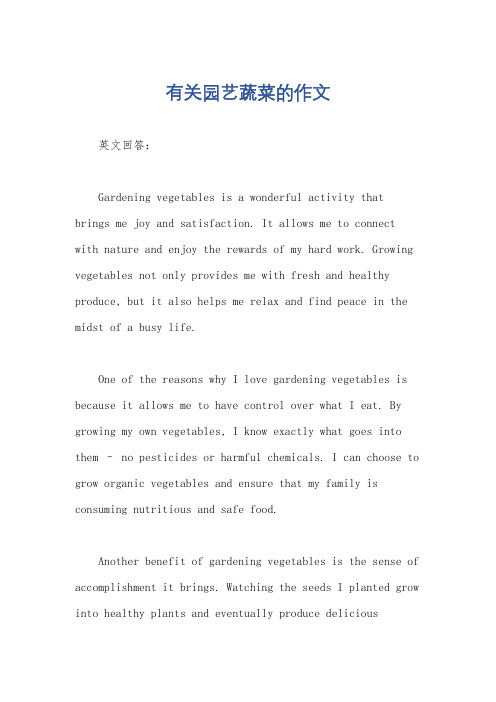
有关园艺蔬菜的作文英文回答:Gardening vegetables is a wonderful activity that brings me joy and satisfaction. It allows me to connect with nature and enjoy the rewards of my hard work. Growing vegetables not only provides me with fresh and healthy produce, but it also helps me relax and find peace in the midst of a busy life.One of the reasons why I love gardening vegetables is because it allows me to have control over what I eat. By growing my own vegetables, I know exactly what goes into them – no pesticides or harmful chemicals. I can choose to grow organic vegetables and ensure that my family is consuming nutritious and safe food.Another benefit of gardening vegetables is the sense of accomplishment it brings. Watching the seeds I planted grow into healthy plants and eventually produce deliciousvegetables is truly rewarding. It gives me a sense of pride and satisfaction, knowing that I am capable of nurturing life and providing for myself and my loved ones.Gardening vegetables also allows me to save money. Instead of buying vegetables from the grocery store, I can grow them in my own backyard. This not only reduces my expenses, but it also gives me the opportunity to experiment with different varieties of vegetables that may not be readily available in stores. I can grow unique and exotic vegetables that add variety to my meals.Furthermore, gardening vegetables is a great way to stay active and get some exercise. The physical labor involved in planting, watering, and tending to the plants keeps me moving and helps me stay fit. It is a form of exercise that doesn't feel like a chore because I am doing something I enjoy.中文回答:园艺种植蔬菜是一项令我快乐和满足的活动。
蔬菜换装英语作文270字
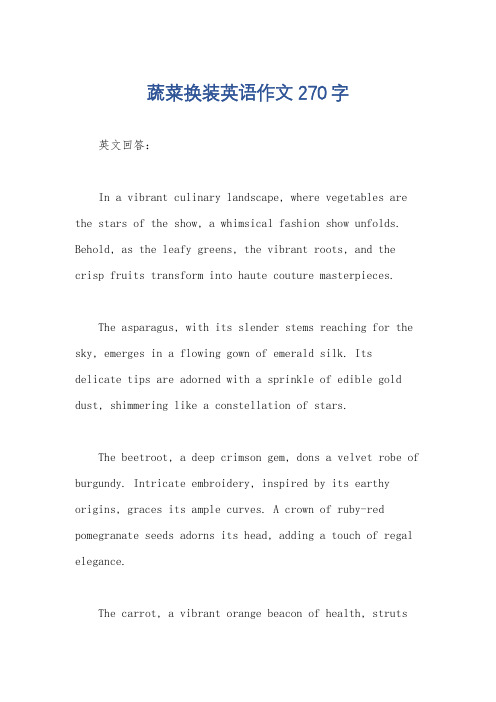
蔬菜换装英语作文270字英文回答:In a vibrant culinary landscape, where vegetables are the stars of the show, a whimsical fashion show unfolds. Behold, as the leafy greens, the vibrant roots, and the crisp fruits transform into haute couture masterpieces.The asparagus, with its slender stems reaching for the sky, emerges in a flowing gown of emerald silk. Itsdelicate tips are adorned with a sprinkle of edible gold dust, shimmering like a constellation of stars.The beetroot, a deep crimson gem, dons a velvet robe of burgundy. Intricate embroidery, inspired by its earthy origins, graces its ample curves. A crown of ruby-red pomegranate seeds adorns its head, adding a touch of regal elegance.The carrot, a vibrant orange beacon of health, strutsits stuff in a tailored suit of saffron and paprika. Its tapered tip becomes a chic hat, jaunty and full of character.The broccoli, with its verdant florets, is a vision of ethereal beauty. A diaphanous dress of pale green chiffon cascades down its stalk, creating an ethereal glow. A tiara of tiny pearl onions crowns its head, adding a touch of whimsical charm.The cucumber, a cool and refreshing cucumber, takes to the runway in a sleek and minimalist ensemble. Its smooth skin is wrapped in a sheath of jade-green silk, adorned with a single, glistening emerald.And finally, the apple, a symbol of wisdom and temptation, makes a grand entrance in a dress of shimmering gold. Its sleek curves are accentuated by intricate lacework, inspired by the autumn leaves that dance in the wind.As the vegetable fashion show concludes, the audienceerupts in applause. The culinary creations, once humble and unassuming, have transformed into works of art, showcasing the boundless creativity and beauty of the natural world.中文回答:在一个充满活力的烹饪世界里,蔬菜就是舞台上的明星,一场奇特的时装秀即将拉开帷幕。
爱好种植蔬菜英语作文高中
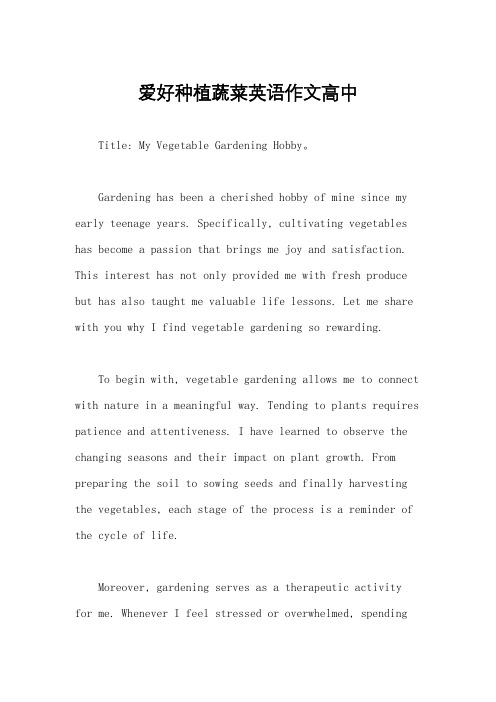
爱好种植蔬菜英语作文高中Title: My Vegetable Gardening Hobby。
Gardening has been a cherished hobby of mine since my early teenage years. Specifically, cultivating vegetables has become a passion that brings me joy and satisfaction. This interest has not only provided me with fresh produce but has also taught me valuable life lessons. Let me share with you why I find vegetable gardening so rewarding.To begin with, vegetable gardening allows me to connect with nature in a meaningful way. Tending to plants requires patience and attentiveness. I have learned to observe the changing seasons and their impact on plant growth. From preparing the soil to sowing seeds and finally harvesting the vegetables, each stage of the process is a reminder of the cycle of life.Moreover, gardening serves as a therapeutic activityfor me. Whenever I feel stressed or overwhelmed, spendingtime in my vegetable garden helps me relax and unwind.There is something incredibly soothing about being surrounded by greenery and hearing the gentle rustle of leaves in the breeze. It is my personal sanctuary away from the hustle and bustle of daily life.Additionally, growing my own vegetables is bothfulfilling and economical. Not only do I get to enjoy fresh, organic produce straight from my garden, but I also save money on grocery bills. There is immense satisfaction in preparing a meal using vegetables that I have nurtured from seedlings.Furthermore, vegetable gardening has taught meimportant lessons about responsibility and perseverance. Plants depend on consistent care, and neglecting them can have adverse consequences. Through trial and error, I have learned to be more patient and attentive, traits that have proven valuable in other aspects of my life as well.In terms of environmental impact, gardening contributes positively by reducing carbon footprint. By growing my ownvegetables, I minimize the need for store-bought produce that often involves long-distance transportation and packaging. This small effort on my part aligns with a larger commitment to sustainable living.In conclusion, my passion for vegetable gardening goes beyond mere hobby. It is a way of life that brings me closer to nature, nurtures my well-being, and imparts valuable lessons. The joy of witnessing a seed grow into a thriving plant is unmatched. I would encourage anyone seeking a fulfilling and enriching pastime to consider starting their own vegetable garden. The rewards are plentiful and extend far beyond the boundaries of the garden itself.。
GBS172.【夏日,请不要放弃深色蔬菜】 请不要放弃英文

【夏日,请不要放弃深色蔬菜】请不要放弃英文近年来,由于食品安全问题频繁出现,特别是夏天,很多人害怕蔬菜中农药含量超标,不得不放弃吃绿色蔬菜,而只吃根茎类蔬菜。
其实,这样的蔬菜结构是不合理的。
营养学界不主张在夏日里放弃绿色蔬菜,改以根茎类蔬菜代替。
推荐:成年人每日摄入蔬菜300~500克,最好深色蔬菜占一半。
近年来,各国膳食指南都强调增加蔬菜摄入的种类和数量。
我国的膳食指南推荐成年人每天吃蔬菜300~500克,而且最好深色蔬菜占一半。
深色蔬菜的营养价值优于浅色蔬菜,富含胡萝卜素尤其?-胡萝卜素,是中国居民维生素A的主要来源;还含有叶绿素、叶黄素、番茄红素、花青素等,具有特殊的生理活性。
Tips:深色蔬菜分类深绿色蔬菜:菠菜、油菜、芹菜叶、空心菜、莴苣叶、芥菜、西兰花、茼蒿、韭菜、萝卜缨等。
红色、橘红色蔬菜:番茄、胡萝卜、南瓜、红辣椒等。
紫红色蔬菜:紫甘蓝、红苋菜等。
夏日:不能拒绝绿色蔬菜,以根茎类蔬菜代替叶子和嫩茎是合成蛋白质最旺盛的场所,最容易受到污染,而农药也往往是喷洒在蔬菜的叶片上,因此,叶类蔬菜的农药残留相对严重;根茎类埋在地底下,不易招虫,农药污染相对较小。
近年来,由于食品安全问题频繁出现,特别是夏天,很多人害怕蔬菜中农药含量超标而不敢吃绿色蔬菜,转而只吃根茎类蔬菜。
殊不知,这样的蔬菜结构是不合理的,因为不同的蔬菜其营养价值相差很大。
比如,嫩茎、叶、花菜类蔬菜(如白菜、菠菜、西兰花),是胡萝卜素、维生素C、维生素B2、叶绿素、矿物质及膳食纤维的良好来源。
即使是同一种蔬菜,不同部位营养素含量也不同,叶部的营养素含量高于根茎部,如莴苣叶、芹菜叶所含的维生素比相应茎根部高出数倍。
叶菜类蔬菜的营养价值也高于瓜菜。
再说,根茎部蔬菜如马铃薯、芋头、山药及水生蔬菜如菱角和莲藕等,含淀粉较多,摄入过多,能量容易超标,导致肥胖。
须知:夏日吃蔬菜有安全等级不同蔬菜由于生长周期、受病虫害污染程度等不同,为了保全蔬菜的“面子”,菜农所使用的农药量会有很大差异。
《野菜的田园小发现》
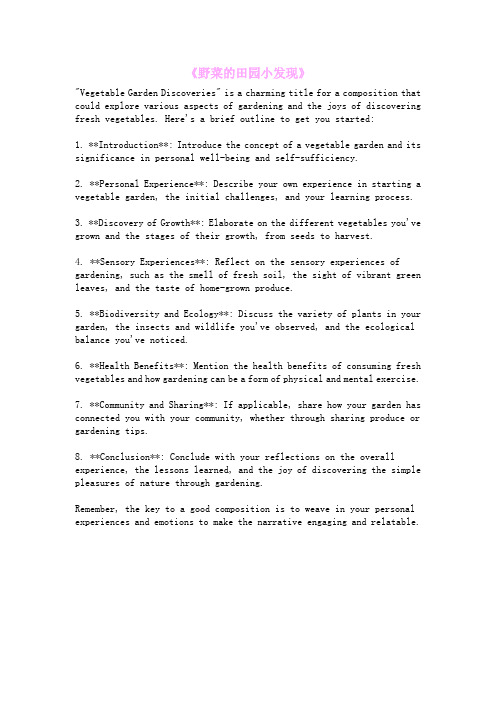
《野菜的田园小发现》"Vegetable Garden Discoveries" is a charming title for a composition that could explore various aspects of gardening and the joys of discovering fresh vegetables. Here's a brief outline to get you started:1. **Introduction**: Introduce the concept of a vegetable garden and its significance in personal well-being and self-sufficiency.2. **Personal Experience**: Describe your own experience in starting a vegetable garden, the initial challenges, and your learning process.3. **Discovery of Growth**: Elaborate on the different vegetables you've grown and the stages of their growth, from seeds to harvest.4. **Sensory Experiences**: Reflect on the sensory experiences of gardening, such as the smell of fresh soil, the sight of vibrant green leaves, and the taste of home-grown produce.5. **Biodiversity and Ecology**: Discuss the variety of plants in your garden, the insects and wildlife you've observed, and the ecological balance you've noticed.6. **Health Benefits**: Mention the health benefits of consuming fresh vegetables and how gardening can be a form of physical and mental exercise.7. **Community and Sharing**: If applicable, share how your garden has connected you with your community, whether through sharing produce or gardening tips.8. **Conclusion**: Conclude with your reflections on the overall experience, the lessons learned, and the joy of discovering the simple pleasures of nature through gardening.Remember, the key to a good composition is to weave in your personal experiences and emotions to make the narrative engaging and relatable.。
观察蔬菜的作文
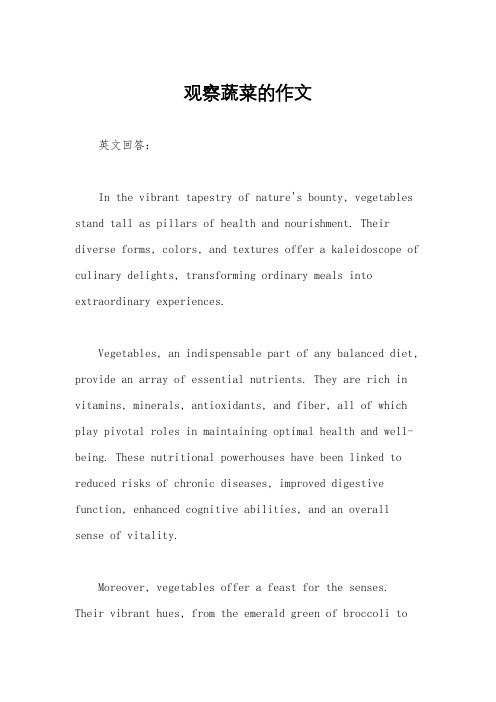
观察蔬菜的作文英文回答:In the vibrant tapestry of nature's bounty, vegetables stand tall as pillars of health and nourishment. Their diverse forms, colors, and textures offer a kaleidoscope of culinary delights, transforming ordinary meals into extraordinary experiences.Vegetables, an indispensable part of any balanced diet, provide an array of essential nutrients. They are rich in vitamins, minerals, antioxidants, and fiber, all of which play pivotal roles in maintaining optimal health and well-being. These nutritional powerhouses have been linked to reduced risks of chronic diseases, improved digestive function, enhanced cognitive abilities, and an overall sense of vitality.Moreover, vegetables offer a feast for the senses. Their vibrant hues, from the emerald green of broccoli tothe deep crimson of beets, add a burst of color to every plate. The crisp crunch of carrots, the tender chewiness of asparagus, and the delicate sweetness of peas create a symphony of textures that tantalize the taste buds. Each bite of a fresh vegetable is a testament to the beauty and diversity of nature's offerings.From the humble onion to the exotic artichoke, vegetables come in a myriad of shapes and sizes. The oblong cucumber, with its smooth, waxen skin, contrasts starkly with the fractal beauty of cauliflower, its intricate florets forming a miniature forest. The towering cornstalk, adorned with rows of plump kernels, stands in silent majesty, while the graceful vines of peas cascade down trellises, their tendrils reaching for the sun.Vegetables have inspired countless culinary creations throughout history. They grace salads with their freshness, add depth to soups and stews, and become the stars of hearty roasts and grilled platters. Whether savored raw, steamed, sautée d, or roasted, vegetables offer endless culinary possibilities, satisfying both the palate and thebody's nutritional needs.In addition to their culinary and nutritional value, vegetables hold cultural significance in many societies. They have been woven into folklore, traditions, and religious practices. The harvest festival, celebrated worldwide, pays homage to the bounty of vegetables and ensures their availability during the leaner months.中文回答:观察蔬菜。
《碳环芳香核酸》课件

• 低聚stilbene类化合物也被发现有抗菌活性,如kobophenol A、phenanthrene衍生物、bis (bibenzyls) marchantin A
• 1993年 通过把葡萄中的stilbene合成酶的基因导入烟草中进 行表达,发现导入此基因的烟草在B.cinerea感染时产生 resveratrol,并有了更高的抵抗力,这提供了stilbene类化 合物抵御感染、提高抗病力的直接证据。
成。
• resveratrol, piceid能够影响白细胞中花生四烯酸的代谢。二者能抑制鼠腹腔多核白细胞中5-脂 氧合酶的产物5-HETE (5-羟基-24碳四烯酸) 及环氧化酶的产物HHT (羟基十七碳烯酸)与TXB2 (血栓烷B2) 的形成。
• Piceid能够防止动脉内皮损伤性血栓的形成, 抑制血小板聚集和TXA2的产生。 • Piceid抑制血小板聚集的途径是通过前列腺系统, 还可能与增加前列环素(PGI2)的释放, 抑制
• 广义定义:天然界存在的一系列多酚化合物,分子量 300~3000。
• 特性:
– 易与蛋白质、生物碱结合生成沉淀 – 易与重金属离子络和。 – 不稳定,酸、碱、氧化 – 水溶性,难溶于有机溶剂
研究历史
• 1785 gallic acid • 1796 Seguin提出tannin命名 • 20世纪初 Fischer、 Freudenberg、Karrer开始结构研究 • 1945 Haslam,Freudenberg,Roux开始系统研究 • 1970以后,奥田拓男、西岗五夫有突破性进展,发现了
微差别,用GC/GC-MS联用分析及TLC制备的方法来研究小量植 物样品中的bibenzyls, 9,10-dihydrophenanthrenes等成分 的报道。
有关各类植物的雅思词汇
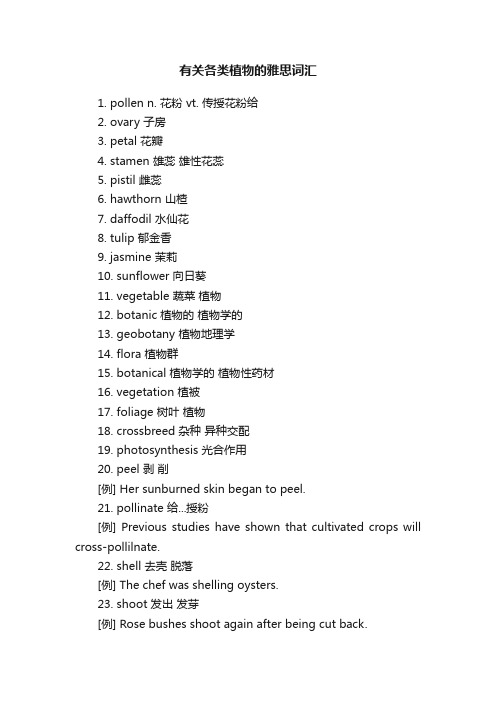
有关各类植物的雅思词汇1. pollen n. 花粉 vt. 传授花粉给2. ovary 子房3. petal 花瓣4. stamen 雄蕊雄性花蕊5. pistil 雌蕊6. hawthorn 山楂7. daffodil 水仙花8. tulip 郁金香9. jasmine 茉莉10. sunflower 向日葵11. vegetable 蔬菜植物12. botanic 植物的植物学的13. geobotany 植物地理学14. flora 植物群15. botanical 植物学的植物性药材16. vegetation 植被17. foliage 树叶植物18. crossbreed 杂种异种交配19. photosynthesis 光合作用20. peel 剥削[例] Her sunburned skin began to peel.21. pollinate 给...授粉[例] Previous studies have shown that cultivated crops will cross-pollilnate.22. shell 去壳脱落[例] The chef was shelling oysters.23. shoot 发出发芽[例] Rose bushes shoot again after being cut back.24. starch 淀粉25. vitamin 维他命维生素26. cell 单元细胞27. tissue 组织[例] The tissues of the body constitute the organ.28. bud 芽发芽[例] The trees budded in early April.29. trunk 干线树干30. bark 树皮31. branch 枝分支32. timber 木材木料33. sprout 萌芽长出[例] The plants sprouted from the ground a week after I planted.34. shrub 灌木灌木丛35. fern 蕨类植物36. fructification 结果实结实器官37. blossom 开花兴旺38. pullulate 发芽抽芽39. tassel 抽穗。
- 1、下载文档前请自行甄别文档内容的完整性,平台不提供额外的编辑、内容补充、找答案等附加服务。
- 2、"仅部分预览"的文档,不可在线预览部分如存在完整性等问题,可反馈申请退款(可完整预览的文档不适用该条件!)。
- 3、如文档侵犯您的权益,请联系客服反馈,我们会尽快为您处理(人工客服工作时间:9:00-18:30)。
ReviewVegetable tannins –Lessons of a phytochemical lifetimeEdwin HaslamDepartment of Chemistry,Dainton Building,University of Sheffield,S37HF,UKReceived 17May 2007;received in revised form 28August 2007;accepted 13September 2007Available online 26November 2007Dedicated to the scientific legacies of E.C.Bate-Smith and Tony Swain,founding fathers of the Plant Phenolics Group later to becomethe Phytochemical Society of Europe.AbstractAfter the early encouragement from the outstanding contribution in the early 1900s of Emil Fischer to an understanding of veg-etable tannins the work of the following half-century had simply exemplified the complexity of the problems they presented.It was generally recognised [Freudenberg,1920.Die Chemie der Natu ¨rliche Gerbstoffe.Springer,Berlin]that there was a broad division into condensed or non-hydrolysable and hydrolysable tannins but much else remained vague and untidy.In the 1950s Bate-Smith and Swain gave the lead into totally new ways of looking at these substances.They drew aside for the first time the curtains on the botanical aspects of these substances to reveal the rich vistas which lay beyond.It was to initiate remarkable progress in the next fifty years in the understanding of their chemistry and biochemistry;some of the principal developments of this work are reviewed herein.Ó2007Elsevier Ltd.All rights reserved.Keywords:Vegetable tannins;Galloyl and hexahydroxydiphenoyl esters;Condensed proanthocyanidins;Structure and biosynthesis;Comparative bio-chemistry;AstringencyContents 1.Introduction and occurrence.................................................................27132.Structure and biosynthesis ..................................................................27142.1.Gallotannins and ellagitannins ..............................................................27142.2.Proanthocyanidins.......................................................................27152.3.Metabolic comparisons and relationships.......................................................27173.Protein –vegetable tannin interactions .........................................................27183.1.Taste and astringency ....................................................................27184.Reflections .............................................................................2719References .............................................................................27201.Introduction and occurrenceProgress in scientific research hinges on the continual discovery of new methods and techniques.The discovery in 1943by Martin and Synge of paper chromatography0031-9422/$-see front matter Ó2007Elsevier Ltd.All rights reserved.doi:10.1016/j.phytochem.2007.09.009E-mail address:edwin.haslam@/locate/phytochemAvailable online at Phytochemistry 68(2007)2713–2721PHYTOCHEMISTRYprovided for thefirst time the means of surveying the phe-nolic constituents of plants and for their separation and identification.There was an explosion of activity in this field after1945,none more so than that of Bate-Smith and Tony Swain.Bate-Smith’s own surveys of the com-moner phenolic constituents from over1500species of plants from nearly one half of the known plant families (dicotyledons;Bate-Smith,1962)is a lasting testament–a work for all ages and affectionately known in some quar-ters as‘Bate-Smithery’.As a result of this and the work of others,the occurrence of vegetable tannins in over80dicot-yledonous plant families has been described and the greater preponderance amongst these of those referred to as con-densed tannins noted.Detailed studies have also been reported on the presence of particular groups of hydrolysa-ble tannins in members of the orders Hammamelidales, Fagales,Dilleniales,Theales,Ericales,Rosales,Myrtales, Cornales,Proteales,Sapindales,Geraniales and Juglan-dales.Of equal importance however was that this work signposted directions for future researches in this area and away from those simply associated with the processes of vegetable tannage and leather manufacture.Substantial accumulations of vegetable tannins may occur in almost any part of a plant–seeds,fruit,leaves, wood,bark,root.Increased tannin production is often associated with a particular pathological condition;the most familiar is that of plant galls caused by insect attack.Leaves of sumach(Rhus typhina)thus contain some12%(dry weight)of a tannin based on gallic acid, most commonly referred to as tannic acid.The hard car-apace of Chinese galls(leaves,Rhus semialata)contains up to70%of the same tannin.However the level of veg-etable tannins normally found in most plant tissues,such as fruit and leaves,is in the range2–5%of the fresh weight.A comprehensive and detailed‘hands on’review of the methods available for the detection and measure-ment of tannins in plants is available(Waterman and Mole,1994).2.Structure and biosynthesisAccording to Bate-Smith three classes of phenolic con-stituent overwhelmingly predominate in the leaves of vas-cular plants,leucoanthocyanins,flavonol glycosides and various derivatives of the hydroxycinnamic acids–princi-pally p-coumaric,caffeic,ferulic and sinapic acids.Leucoanthocyanins were originally described by Sir Robert and Lady Robinson in the1930s and named in the belief that these compounds were colourless‘leuco’forms of the parent anthocyanins.Bate-Smith observed that their distribution in plants was very strongly corre-lated with that of condensed vegetable tannins.They are now invariably referred to as proanthocyanidins. One further observation which emerged from these stud-ies and to which Bate-Smith repeatedly drew attention was the enigma of gallic acid.The occurrence of individ-ual hydroxybenzoic acids(o and p-hydroxybenzoic acids, vanillic,protocatechuic)in plants is sporadic and idiosyn-cratic;in certain taxa however that of gallic acid is wide-spread and it is often found in high concentrations.He noted that3,4,5-trihydroxycinnamic acid had not been encountered in his taxonomic work and speculated that gallic acid was the real taxonomic equivalent of the‘miss-ing’3,4,5-trihydroxycinnamic acid.Bate-Smith also con-cluded that the synthetic capabilities to metabolise leucoanthocyanins and the vic-trihydroxyaryl grouping (e.g.esters of gallic acid;gallotannins and ellagitannins) were‘primitive’ones and that once these synthetic capa-bilities had been lost during the course of evolution these changes were irreversible.He concluded that the capacity of plants to synthesise vegetable tannins–both condensed and hydrolysable–was therefore a primitive one.2.1.Gallotannins and ellagitanninsHydrolysable tannins are a classic example of secondary metabolism(Haslam,1995)and are characterised by a number of distinctive features of which three are summa-rised below;a fourth is noted but for which important questions remain.(i)Structural diversity.Hydrolysable tannins are basedupon the fundamental structural unit of gallic acid and are almost invariably found as multiple esters with D-glucose(gallotannins).Derivatives of hexa-hydroxydiphenic acid(ellagitannins)are assumed to be derived by oxidative coupling of adjacent galloyl ester groups in a polygalloyl D-glucose ester,(Schmidt and Mayer,1956),Fig.1.Metabolites number over1000;principally described by Okuda(Okuda et al.,1989,1990,1993)and Nishioka (Nishioka et al.,1985,1990)in Japan.Structural diversity is invariably accomplished by different chemical embellish-ment,usually(vide supra)dehydrogenation or oxygenation, of a key metabolite such as b-1,2,3,4,6-penta-O-galloyl-D-glucose(Cai and Haslam,1994;Haslam,1998);an indica-tion of nature’s economy or her unrestrainedprodigality.2714 E.Haslam/Phytochemistry68(2007)2713–2721(ii)Taxonomic distribution–Hydrolysable tannins have a very restricted taxonomic distribution;they are asso-ciated principally with woody and herbaceous dicot-yledonous plants(Bate-Smith and Metcalfe,1957). (iii)Accumulation and storage–Hydrolysable tannins are regularly characterised by substantial accumulations of particular metabolites in certain tissues.Examples are legion;the fresh leaves of Rhus typhina contain some12–15%of a hepta-to octagalloyl glucose derivative(syn.tannic acid)based upon the further galloylation of the key metabolite b-1,2,3,4,5-penta-O-galloyl-D-glucose;the young leaves(flush)of the tea plant(Camellia sinensis)contains3–4%caffeine and$20–25%of the phenols(À)-epicatechin and (À)-epigallocatechin and their galloyl ester deriva-tives(Lunder,1988).(iv)Induction and regulation–Although Gross and his group(Gross,1999;Haslam,1998)have made sub-stantial progress towards an understanding of the mechanisms involved in the formation of the pivotal metabolite b-1,2,3,4,6-penta-O-galloyl-D-glucose and the various gallotannins from glucose and gallic acid,so far as induction and regulation of gallic acid metabolism are concerned large and significant gaps in our knowledge remain.Indeed,they begin with the biosynthesis of gallic acid itself.Two path-ways,a and b,Fig.2,have been suggested and the weight of experimental evidence favours the former route a,namely direct dehydrogenation of an inter-mediate in the shikimate pathway and retention of the oxygen atoms of the alicyclic precursor(Conn and Swain,1961;Knowles et al.,1961;Dewick and Haslam,1969;Cornthwaite and Haslam,1965;Werner et al.,1997).However,this places gal-lic acid in a potentially unique position when com-pared to the majority of other plant phenols which more generally derive from end-products of the pathway(as in route b,Zenk,1964)and the pheno-lic groups are derived by direct oxygen insertion into the aromatic nucleus.Clearly work at the enzy-mic and/or genetic level is necessary to resolve this question.2.2.ProanthocyanidinsOf all the changes which Bate-Smith and Swain prompted in the1950s it was that towards the condensed tannins which was to have the greatest impact.They thus directed attention away from the variously intractable commercial extracts,particularly those from the bark and wood of trees–mangrove,oak,hemlock,quebracho, chestnut and cutch–to the invariably more amenable liv-ing tissues of plants.It was revolutionary.They confirmed that the condensed tannins were identical with the leuco-anthocyanins/leucoanthocyanidins,(first recorded by Sir Robert and Lady Robinson in the1930s)and that these latter groups of compound were most commonly respon-sible for the range of reactions in plant tissues attributed to condensed tannins.The fundamental structural unit in this group is the phenolicflavan-3-ol(‘catechin’)nucleus. Condensed proanthocyanidins exist as oligomers(water soluble),containing two to ten or more‘catechin’units, and polymers(water insoluble).Theflavan-3-ol units are linked principally through the4and the8positions. The nomenclature derives from the property whichtheyE.Haslam/Phytochemistry68(2007)2713–27212715possess of degradation in strong acid to give the corresponding anthocyanidin,generally cyanidin and/or delphinidin,Fig.3.Procyanidins (R =H)and prodelphin-idins (R =OH)are the most commonly found types of condensed proanthocyanidins and they are generally asso-ciated with plants which possess a woody habit of growth.In so far as the total complement of condensed proanthocyanidins found in plant tissues is concerned,the soluble oligomeric forms (dimers,trimers ...)are in metabolic terms but the ‘tip of the iceberg’,but they pro-vided the ideal substrates for chemical structure evalua-tion (Weinges et al.,1968,1969;Haslam,1977,1998;Porter,1988,1989;Balas and Vercauteren,1994).How-ever,for the generality of plants it is now quite clear that condensed proanthocyanidins,which are totally insoluble or are insoluble in organic solvents such as ethanol,over-whelmingly predominate.They are,metaphorically speak-ing,the base of the ‘metabolic iceberg’.Indeed in the tissues of some plants such as the Leguminosae (Bate-Smith,1973)ferns and fruit such as the persimmon (Dio-spyros kaki )there is a preponderance of these forms.They are also of frequent occurrence in plant gums and exudates such as Butea frondosa gum.To date their exact structures are not known although,because of their prop-erties,they are presumed to contain the typical proanth-ocyanidin units which give rise to anthocyanidins on treatment with acid.Current lines of thought suggest that the proanthocy-anidins are formed,in some way,(again as with gallic acid still not clearly defined at the biochemical level),as by-products of the processes in which the parent flavan-3-ols are biosynthesised from flavan-3,4-diols,(Stafford and Lester,1982,1984,1985;Stafford et al.,1985;Tanner and Kristiansen,1993).Chemists,familiar with Sir Robert Robinson’s famous dictum that ‘cells obey the laws of chemistry’(Robinson,1955),have suggested (Haslam,1977,1998;Fig.4)that the reduction of the flavan-3,4-diol to the flavan-3-ol proceeds by a two step process via the corresponding quinone methide.Invoking the nucleophilic capture of this intermediate by,for example,the flavan-3-ol then makes possible a wholly reasonable (chemically that is!)route to the proanthocyanidins.Strongsupport2716 E.Haslam /Phytochemistry 68(2007)2713–2721for this idea derives from the fact that this rationale pro-vides the basis for the efficient biomimetic synthesis of proanthocyanidins (Haslam,1974;Hemingway and Foo,1983).Participation of the quinone methide as an intermediate also then makes possible the rationalisation of the epimer-isation at C-3,necessary to explain the formation of the fla-van-3-ol (À)-epicatechin and analogously derived procyanidins.2.3.Metabolic comparisons and relationshipsBoth major groups of vegetable tannins are character-ised by complex structures bearing a multiplicity of phe-nolic groups and by relative molecular masses which,for secondary metabolites,are very high –regularly in excess of 103.Bate-Smith also often stated that,in his view,the capacity of plants to synthesise vegetable tannins –con-densed and hydrolysable –were ‘primitive’ones and once these synthetic capabilities had been lost during the course of evolution these changes were irreversible.A question well worthy of further consideration in the future is whether these two groups of polyphenolic metabolites,despite their acknowledged very distinctive origins (vide supra ,Figs.2and 4),have metabolic or other relationships which extends this kinship further.Two circumstantial pointers in this direction are outlined below.(i)Plants which have a strong capacity to synthesise proanthocyanidins generally do not metabolise substantial quantities of esters of gallic and hexa-hydroxydiphenic acids,and vice-versa.In this context it should also be noted that for the very few plants which biosynthesise galloyl esters of flavan-3-ol sub-strates then very little,if any,proanthocyanidins are found co-occuring.The best known example of this phenomenon is the tea plant (Camellia sinensis )where the metabolic profile is dominated by $20–25%of the phenols (À)-epicatechin and (À)-epigallocatechin and their galloyl ester derivatives (Lunder,1988;Nonaka et al.,1983).(ii)Leaves of plants,in the Northern hemisphere,whichsynthesise substantial quantities of condensed or hydrolysable tannins during normal growth gener-ally ,and under the right external conditions,produce strong anthocyanin pigmentation during autumnal senescence.Each autumn millions of tons of chlorophyll are destroyed in the Northern hemisphere.Accompanying this there are dramatic changes in the colour of the leavesofE.Haslam /Phytochemistry 68(2007)2713–27212717plants from green to the yellow,red and browns of the dying year.In the New England States of America the‘fall’generates over1billion$from tourism in the space of just three weeks.In a wet autumn most leaves do not colour strongly and the journalist Alistair Cooke in his‘Letter from America’(October,1970)stated that the essentials for good autumn colours are‘a poor soil,slight frost and warm sun–in that order’.For a great many plants the leaves,once the chlorophyll has been oxidatively degraded, remain yellow-brown as a result of the presence of residual xanthophylls,etc.However some give spectacular displays as the yellow pigmentation gives way to a rich deep red of anthocyanin pigmentation:invariably,in this context the good performers are those whose normal metabolism gives high levels of proanthocyanidins:however,the veryfinest performers are without doubt those plants which during normal growth produce high levels of gallic acid and its derivatives.Rhus typhina is one such example.It metabolis-es some12–15%of a hepta-to octa galloyl glucose deriva-tive in its leaves.Anthocyanidin synthase is a2-oxoglutarate iron-depen-dent oxygenase(Schofield et al.,2002)which catalyses anthocyanidin formation from the naturalflavan-3,4-diol substrate by a mechanism involving stereoselective C-3 hydroxylation.Rationalisation of the case of anthocyanidin forma-tion during senescence in proanthocyanidin producing plants(e.g.Prunus sp.)might therefore be visualised as a metabolic diversion from reduction at the terminal flavan-3,4-diol stage to oxidation(Fig.5).However,a corresponding metabolic rationalisation of autumnal anthocyanin pigmentation in plants such as Rhus typh-ina is on this basis very far from clear,a mystery in fact.Yet such plants producing gallic acid and its derivatives are quite the most outstanding examples in this respect.Recent work by Walker et al.(2007)points however to another possible explanation of this phenomenon.The Australian group showed that anthocyanin production in grapes is controlled by two separate but related VvMYBA genes and that white grapes only arise where there have been mutations in both of these genes.It has long been known that all wild species of Vitis have dark coloured grapes and this research on the genes of white grapes provides a probable explanation of their origin. In this context one might argue(a´la Bate-Smith)that anthocyanidin formation in grapes is a primitive charac-teristic of Vitis species,lost over the course of evolution. Likewise autumnal anthocyanin synthesis in leaves might well be a similarly primitive characteristic of plants. Moreover if it is also linked to vegetable tannin formation then one might speculate that it has,likewise,been lost, along with the tannins,during the course of evolution. Its retention in those plants which metabolise vegetable tannins could therefore be viewed as evidence that it is a metabolic process entirely complimentary to tannin synthesis.3.Protein–vegetable tannin interactionsVegetable tannage of animal skins represents just one specific example of a physical phenomenon which is wide-spread,namely the association(complexation)of vegeta-ble tannins with natural macromolecules and a range of small molecules(Haslam,1998).These interactions are of considerable technical significance in areas as diverse as agriculture,ecology and food selection,foodstuffs and nutrition,the taste of beverages(astringency),herbal medicines,floral pigmentation,and the formation of nat-ural glues and varnishes.Pre-eminent amongst these phe-nomena are those which derive primarily from the interaction with proteins.Considerable progress has been made in recent years in the understanding and application of many of these properties at the molecular level, (Haslam,1998).However,in so far as their participation in all these phenomena is concerned,it is that group of polyphenolic compounds described by the initial phrase in Bate-Smith and Swain’s(1962)original description of vegetable tannins,upon which attention should be pri-marily focussed:–‘Water soluble phenolic compounds hav-ing molecular weights between500and3000and,besides giving the usual phenolic reactions,they have special prop-erties such as the ability to precipitate alkaloids,gelatin and other proteins’.3.1.Taste and astringencySaliva is produced by the salivary glands which empty their secretions into the oral cavity and contains a group of unique proteins which are usually referred to as‘pro-line-rich proteins’:PRPs.Proline accounts for25–42%of the amino acids in isolated PRPs.In addition there are high contents of glutamine(glutamic acid)and glycine and these three residues account for70–88%of all amino acids in the proteins(Fig.6;Bennick,1982).The phe-nomenon of astringency–a desirable characteristic of many beverages such as wines,ciders,teas,etc.–is believed to be associated specifically with the interaction of polyphenols with PRPs.Astringency is generally recognised as a loss of lubrica-tion,a feeling of extreme puckeriness and dryness in the palate.It is not confined to a particular region but is expe-rienced as a diffuse stimulus which invariably takes afinite time to develop fully(Joslyn and Goldstein,1964).The2718 E.Haslam/Phytochemistry68(2007)2713–2721primary reaction is thought to be via the precipitation of proteins and mucopolysaccharides in the mucous secre-tions caused by the astringent principles.A pictorial repre-sentation of the process whereby polyphenols (tannins)are envisaged to act at the molecular level to complex with salivary PRPs and bring about the astringent response is depicted in Fig.7.An essential feature is the cross-linking of adjacent polypeptide chains of the PRPs by polyphenol molecules giving rise to the formation of aggregates and precipitation of the salivary PRPs.In turn,this leads to the loss of lubrication in the palate and the sensation of astringency.The whole process is a time dependent and dynamic one and requires a period of time to develop fully.A necessary feature of this model is that the poly-phenol should be of sufficient size and composition to bring about,by polydentate binding,the cross-linking process.Studies show that the strong affinity which poly-phenols have towards PRPs also derives from the loose,random coil structures of the PRPs which afford a large surface area for complexation and from a specific com-plexation of the phenolic nuclei with the proline residues in the PRPs.The pyrrolidine rings of the prolyl residues provide a multiplicity of binding sites (‘hydrophobic sticky patches’)on the PRPs and exert a strong,selective influence on the complexation process.The extensive data compiled by Wil-liamson and his colleagues (Murray and Williamson,1994;Murray et al.,1994;Luck et al.,1994)suggest that there is ‘face-to-face’hydrophobic stacking of the prolyl and aro-matic groups,with subsequent hydrogen bonding of one or more phenolic hydroxyl groups to the tertiary amide group N-terminal to the prolyl residue.Preferential binding occurs at the N-terminal prolyl group in an oligoproline sequence.4.ReflectionsThe researches of Bate-Smith and Swain in the 1950s and beyond initiated remarkable progress in the next fifty years in the understanding of the chemistry and biochem-istry of vegetable tannins;for those who have followed in their pioneering footsteps a minor transcription of the words of Sir Isaac Newton (1675)‘If we have seenfurtherFig.7.Multidentate cross-linking of PRP molecules by polyphenolic molecules (tannins)with concomitant loss of lubrication and development of the astringent response.E.Haslam /Phytochemistry 68(2007)2713–27212719it is by standing on the shoulders of giants’eloquently expresses this debt.However,it is also important to recall the benefits which Bate-Smith and Swain themselves derived from the optimism and scientific ethos of those days,namely that fundamental studies‘of those things not yet considered important’were encouraged.It is an argument with which scientists have been faced repeat-edly over the past250years,for as many of the subse-quent developments in this particularfield amply demonstrate yet again‘There are no such things as applied sciences,only applications of science’,(Pasteur, 1872).ReferencesBalas,L.,Vercauteren,J.,1994.Extensive high resolution reverse2D NMR analysis allows structural elucidation of procyanidin oligomers.Mag.Res.Chem.33,386–393.Bate-Smith,E.C.,1962.The phenolic constituents of plants and their taxonomic significance.I.Dicotyledons.J.Linn.Soc.(Bot.)58,95–173.Bate-Smith, E.C.,1973.Tannins of herbaceous Leguminosae.Phyto-chemistry12,1809–1812.Bate-Smith,E.C.,Metcalfe,C.R.,1957.Leucoanthocyanins3.The nature and systematic distribution of tannins in dicotyledonous plants.J.Linn.Soc.(Bot.)55,669–705.Bate-Smith,E.C.,Swain,T.,1962.In:Mason,H.S.,Florkin,A.M.(Eds.), Comparative Biochemistry.Springer,Berlin,p.764.Bennick,A.,1982.Salivary proline-rich proteins.Mol.Cell.Biochem.45, 83–99.Cai,Y.,Haslam,E.,1994.Plant polyphenols(vegetable tannins):gallic acid metabolism.Nat.Prod.Rep.11,41–66.Conn,E.E.,Swain,T.,1961.Biosynthesis of gallic acid in higher plants.Chem.Ind.,592–593.Cornthwaite,D.C.,Haslam,E.,1965.Gallotannins9.The biosynthesis of gallic acid in Rhus typhina.J.Chem.Soc.,3008–3011.Dewick,P.M.,Haslam,E.,1969.The biosynthesis of gallic acid in higher plants.Biochem.J.113,537–542.Freudenberg,K.,1920.Die Chemie der Natu¨rliche Gerbstoffe.Springer, Berlin.Gross,G.G.,1999.Biosynthesis of hydrolysable tannins.In:Pinto,B.M.(Ed.),Comprehensive Natural Products Chemistry,vol.3.Elsevier, Amsterdam,pp.799–826.Haslam,E.,1974.Biogenetically patterned synthesis of procyanidins.J.Chem.Soc.,m.,594–595.Haslam, E.,1977.Symmetry and promiscuity in proanthocyanidin biochemistry.Phytochemistry16,1625–1640.Haslam, E.,1995.Secondary metabolism–evolution and function;products or processes?Chemoecology5(6),89–95.Haslam,E.,1998.Practical polyphenolics:from structure to molecular recognition and physiological action.Cambridge University Press, Cambridge,New York,Melbourne.Hemingway,R.W.,Foo,L.Y.,1983.Quinone methide intermediates in procyanidin synthesis.J.Chem.Soc.,m.,1035–1036. Joslyn,M.A.,Goldstein,J.L.,1964.Astringency of fruits and fruit products in relation to phenolic content.Adv.Food Res.13,179–217. Knowles,P.F.,Haworth,R.D.,Haslam,E.,1961.Gallotannins IV.The biosynthesis of gallic acid.J.Chem.Soc.,1854–1859.Luck,G.,Liao,H.,Murray,N.J.,Grimmer,H.R.,Warminski,E.E., Williamson,M.P.,Lilley,T.H.,Haslam, E.,1994.Polyphenols, astringency and proline-rich proteins.Phytochemistry37,357–371. Lunder,T.V.,1988.Tea.Nestle,Nestec pany,Vevey,Suisse. Murray,N.J.,Williamson,M.P.,1994.Conformational study of a salivary proline-rich protein repeat sequence.Eur.J.Biochem.219,915–921.Murray,N.J.,Williamson,M.P.,Lilley,T.H.,Haslam,E.,1994.Study of the interaction between proline-rich proteins and a polyphenol by1H NMR spectroscopy.Eur.J.Biochem.219,923–935.Nishioka,I.,Nonaka,G.,Ageta,M.,1985.Tannins and related compounds.25.A new class of gallotannins possessing a(À)-shikimic acid core from Castanopsis cuspidata var.sieboldii Nakai..Chem.Pharm.Bull.33,96–101.Nishioka,I.,Nonaka,G.,Tanaka,T.,Sakai,T.,Mihashi,K.,1990.Tannins and related compounds.97.Structural revision of C-glyco-sidic ellagitannins,castalagin,vescalagin,casuarinin and stachyurin and related hydrolysable ellagitannins.Chem.Pharm.Bull.38,2151–2156,and references therein.Nonaka,G.-I.,Kawahara,O.,Nishioka,I.,1983.Tannins and related compounds XV.A new class of dimericflavan-3-ol gallates,theasi-nensins A and B,and proanthocyanidin gallates from green tea leaf.Chem.Pharm.Bull.31,61–65.Okuda,T.,Hatano,T.,Yoshida,T.,1989.New methods of analysing tannins.J.Nat.Prod.52,1–31.Okuda,T.,Hatano,T.,Yoshida,T.,1990.Oligomeric hydrolysable tannins,a new class of plant polyphenols.Heterocycles30,1195–1218.Okuda,T.,Hatano,T.,Yoshida,T.,1993.Polyphenols of new types and their correlation with plant systematics.Phytochemistry32,507–522. Porter,L.J.,1988.Flavans and proanthocyanidins.In:Harborne,J.B.(Ed.),The Flavanoids:Advances in Research Since1980.Chapman and Hall,London,pp.21–62.Porter,L.J.,1989.Tannins.In:Harborne,J.B.(Ed.),Methods in Plant Biochemistry,Plant Phenolics,Vol.1.Academic Press,London and New York,pp.389–419.Robinson,R.,1955.The Structural Relationships of Natural Products.Clarendon Press,Oxford,150.Schmidt,O.Th.,Mayer,W.,1956.Natu¨rliche gerbstoffe.Angewandte Chemie68,103–115.Schofield,C.J.,Wilmouth,R.C.,Turnbull,J.J.,Welford,R.W.D.,Clifton,I.J.,Prescott,A.G.,2002.Structure and mechanism of anthocyanidinsynthase from Arabidopsis thaliana.Structure10,93–103.Stafford,H.A.,Lester,H.H.,1982.Enzymatic and non-enzymatic reduction of(+)-dihydroquercetin to its3,4-diol.Plant Physiol.70, 695–698.Stafford,H.A.,Lester,H.H.,1984.Flavan-3-ol biosynthesis.The conver-sion of(+)-dihydroquercetin andflavan-3,4-diol(leucocyanidin)to (+)-catechin by reductases from cell suspension cultures of Douglasfir.Plant Physiol.76,184–186.Stafford,H.A.,Lester,H.H.,1985.Flavan-3-ol biosynthesis.The conver-sion of(+)-dihydromyricetin and itsflavan-3,4-diol(leudelphinidin)to (+)-gallocatechin by reductases extracted from tissue cultures of Gingko biloba and Pseudotsuga menziesii.Plant Physiol.78,791–794. Stafford,H.A.,Lester,H.H.,Porter,L.J.,1985.Chemical and enzymic synthesis of monomeric procyanidins(leucocyanidins)from2R,3R-dihydroquercetin.Phytochemistry24,333–338.Tanner,G.J.,Kristiansen,K.N.,1993.Synthesis of3,4-cis-leucocyanidin and enzymatic reduction to catechin.Anal.Biochem.209,274–277. Walker, A.R.,Lee, E.,Bogs,J.,McDavid, D.A.J.,Thomas,M.R., Robinson,S.P.,2007.White grapes arose through the mutation of two similar and adjacent regulatory genes.Plant J.49,772–785. Waterman,P.G.,Mole,S.,1994.Analysis of Plant Phenolic Metabolites.Blackwell,London,Edinburgh and Boston.Weinges,K.,Marx,H.-D.,Kaltenhauser,W.,Nader, E.,Nader, F., Perner,J.,Seiler,D.,1968.Procyanidine aus fru¨chten.Liebigs Ann.711,184–204.Weinges,K.,Bahr,W.,Ebert,W.,Goritz,K.,Marx,H.-D.,1969.Konstitution enstehung und bedeutung derflavonoid-gerbstoffe.Fortschrit .Nat.27,158–260.Werner,I.,Bacher,A.,Eisenreich,W.,1997.Retrobiosynthetic NMR studies with13C labelled glucose.Formation of gallic acid in plants and fungi.J.Biol.Chem.272,25474–25482.Zenk,M.H.,1964.Zur frage der biosynthese von gallussa¨ure.Z.Naturforsch.19b,83–84.2720 E.Haslam/Phytochemistry68(2007)2713–2721。
